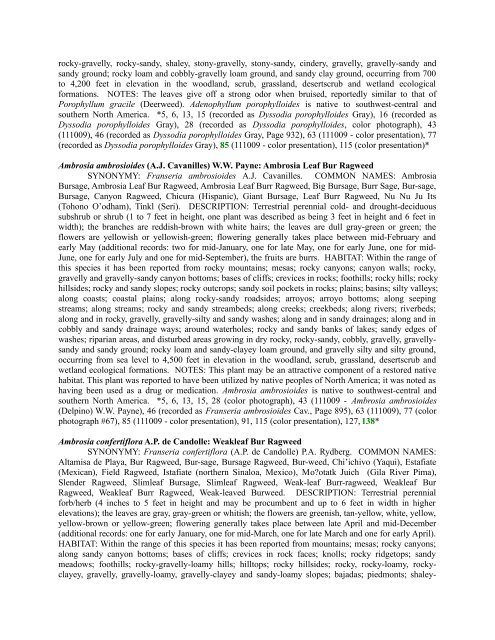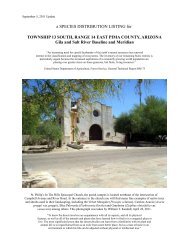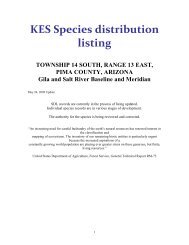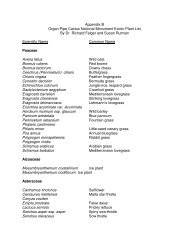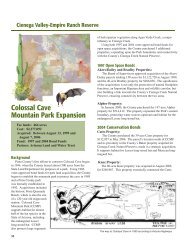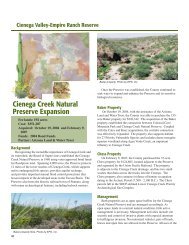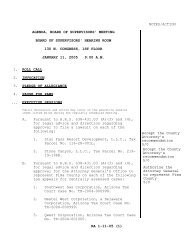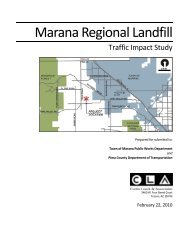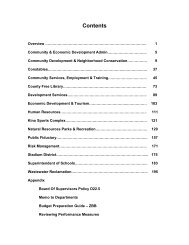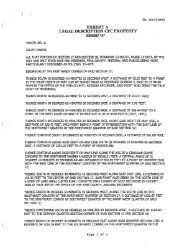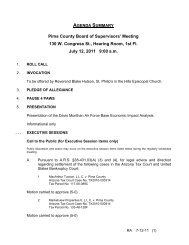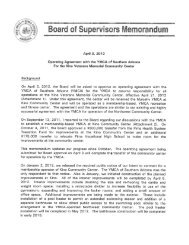Le Jardin de Mère Nature dans une Petite Planète - Pima County
Le Jardin de Mère Nature dans une Petite Planète - Pima County
Le Jardin de Mère Nature dans une Petite Planète - Pima County
You also want an ePaper? Increase the reach of your titles
YUMPU automatically turns print PDFs into web optimized ePapers that Google loves.
ocky-gravelly, rocky-sandy, shaley, stony-gravelly, stony-sandy, cin<strong>de</strong>ry, gravelly, gravelly-sandy and<br />
sandy ground; rocky loam and cobbly-gravelly loam ground, and sandy clay ground, occurring from 700<br />
to 4,200 feet in elevation in the woodland, scrub, grassland, <strong>de</strong>sertscrub and wetland ecological<br />
formations. NOTES: The leaves give off a strong odor when bruised, reportedly similar to that of<br />
Porophyllum gracile (Deerweed). A<strong>de</strong>nophyllum porophylloi<strong>de</strong>s is native to southwest-central and<br />
southern North America. *5, 6, 13, 15 (recor<strong>de</strong>d as Dyssodia porophylloi<strong>de</strong>s Gray), 16 (recor<strong>de</strong>d as<br />
Dyssodia porophylloi<strong>de</strong>s Gray), 28 (recor<strong>de</strong>d as Dyssodia porophylloi<strong>de</strong>s, color photograph), 43<br />
(111009), 46 (recor<strong>de</strong>d as Dyssodia porophylloi<strong>de</strong>s Gray, Page 932), 63 (111009 - color presentation), 77<br />
(recor<strong>de</strong>d as Dyssodia porophylloi<strong>de</strong>s Gray), 85 (111009 - color presentation), 115 (color presentation)*<br />
Ambrosia ambrosioi<strong>de</strong>s (A.J. Cavanilles) W.W. Payne: Ambrosia <strong>Le</strong>af Bur Ragweed<br />
SYNONYMY: Franseria ambrosioi<strong>de</strong>s A.J. Cavanilles. COMMON NAMES: Ambrosia<br />
Bursage, Ambrosia <strong>Le</strong>af Bur Ragweed, Ambrosia <strong>Le</strong>af Burr Ragweed, Big Bursage, Burr Sage, Bur-sage,<br />
Bursage, Canyon Ragweed, Chicura (Hispanic), Giant Bursage, <strong>Le</strong>af Burr Ragweed, Nu Nu Ju Its<br />
(Tohono O’odham), Tinkl (Seri). DESCRIPTION: Terrestrial perennial cold- and drought-<strong>de</strong>ciduous<br />
subshrub or shrub (1 to 7 feet in height, one plant was <strong>de</strong>scribed as being 3 feet in height and 6 feet in<br />
width); the branches are reddish-brown with white hairs; the leaves are dull gray-green or green; the<br />
flowers are yellowish or yellowish-green; flowering generally takes place between mid-February and<br />
early May (additional records: two for mid-January, one for late May, one for early J<strong>une</strong>, one for mid-<br />
J<strong>une</strong>, one for early July and one for mid-September), the fruits are burrs. HABITAT: Within the range of<br />
this species it has been reported from rocky mountains; mesas; rocky canyons; canyon walls; rocky,<br />
gravelly and gravelly-sandy canyon bottoms; bases of cliffs; crevices in rocks; foothills; rocky hills; rocky<br />
hillsi<strong>de</strong>s; rocky and sandy slopes; rocky outcrops; sandy soil pockets in rocks; plains; basins; silty valleys;<br />
along coasts; coastal plains; along rocky-sandy roadsi<strong>de</strong>s; arroyos; arroyo bottoms; along seeping<br />
streams; along streams; rocky and sandy streambeds; along creeks; creekbeds; along rivers; riverbeds;<br />
along and in rocky, gravelly, gravelly-silty and sandy washes; along and in sandy drainages; along and in<br />
cobbly and sandy drainage ways; around waterholes; rocky and sandy banks of lakes; sandy edges of<br />
washes; riparian areas, and disturbed areas growing in dry rocky, rocky-sandy, cobbly, gravelly, gravellysandy<br />
and sandy ground; rocky loam and sandy-clayey loam ground, and gravelly silty and silty ground,<br />
occurring from sea level to 4,500 feet in elevation in the woodland, scrub, grassland, <strong>de</strong>sertscrub and<br />
wetland ecological formations. NOTES: This plant may be an attractive component of a restored native<br />
habitat. This plant was reported to have been utilized by native peoples of North America; it was noted as<br />
having been used as a drug or medication. Ambrosia ambrosioi<strong>de</strong>s is native to southwest-central and<br />
southern North America. *5, 6, 13, 15, 28 (color photograph), 43 (111009 - Ambrosia ambrosioi<strong>de</strong>s<br />
(Delpino) W.W. Payne), 46 (recor<strong>de</strong>d as Franseria ambrosioi<strong>de</strong>s Cav., Page 895), 63 (111009), 77 (color<br />
photograph #67), 85 (111009 - color presentation), 91, 115 (color presentation), 127, 138*<br />
Ambrosia confertiflora A.P. <strong>de</strong> Candolle: Weakleaf Bur Ragweed<br />
SYNONYMY: Franseria confertiflora (A.P. <strong>de</strong> Candolle) P.A. Rydberg. COMMON NAMES:<br />
Altamisa <strong>de</strong> Playa, Bur Ragweed, Bur-sage, Bursage Ragweed, Bur-weed, Chi’ichivo (Yaqui), Estafiate<br />
(Mexican), Field Ragweed, Istafiate (northern Sinaloa, Mexico), Mo?otatk Juich (Gila River <strong>Pima</strong>),<br />
Slen<strong>de</strong>r Ragweed, Slimleaf Bursage, Slimleaf Ragweed, Weak-leaf Burr-ragweed, Weakleaf Bur<br />
Ragweed, Weakleaf Burr Ragweed, Weak-leaved Burweed. DESCRIPTION: Terrestrial perennial<br />
forb/herb (4 inches to 5 feet in height and may be procumbent and up to 6 feet in width in higher<br />
elevations); the leaves are gray, gray-green or whitish; the flowers are greenish, tan-yellow, white, yellow,<br />
yellow-brown or yellow-green; flowering generally takes place between late April and mid-December<br />
(additional records: one for early January, one for mid-March, one for late March and one for early April).<br />
HABITAT: Within the range of this species it has been reported from mountains; mesas; rocky canyons;<br />
along sandy canyon bottoms; bases of cliffs; crevices in rock faces; knolls; rocky ridgetops; sandy<br />
meadows; foothills; rocky-gravelly-loamy hills; hilltops; rocky hillsi<strong>de</strong>s; rocky, rocky-loamy, rockyclayey,<br />
gravelly, gravelly-loamy, gravelly-clayey and sandy-loamy slopes; bajadas; piedmonts; shaley-


